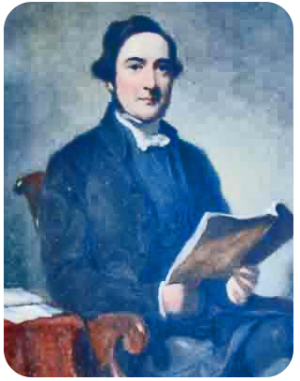James Hemery was born on 30 April 1814, baptised on 4 May 1814 and died on 22 November 1849. From a young age he tended towards serious and religious studies. He was a keen rower and cricketer, he attended Westminster School from 1827, being King’s Scholar in 1828. He rowed at six in a race against Eton in 1831.
Elected to Trinity College Cambridge in 1833, scholar 1834, gained his BA in Mathematics in 1837, at this time his ‘humility and sincere piety impressed’ He was MA in 1840, made a Fellow of Trinity College in 1839, assistant tutor of Trinity 1839–1844, ordained deacon in 1841 and priest in 1842, Rector of St Helier, and Dean of Jersey from 21 December 1844 until his death in 1849.
Popular choice
The island had expected Henry John Knapp to be chosen Dean, but the Crown chose James Hemery. He was named Dean by Her Majesty on 9 November 1844, and on 21 November 1844 named Rector of the Parish of St Helier by Lord Beresford, Governor of Jersey. His obituary records that ‘His nomination was greeted with much satisfaction by all parties and all classes of our community’ He married Ellen Charlotte Newcourt daughter of Thomas Newcourt on 15 May 1845 at Oxford.
For three years no one worked with more passion, more eloquence, more activity or more success. He administered the Jean Le Brocq bequest of 25 Qrs to the ‘pauvres honteux de cette ile’
In the Jersey Archive there is a report in French dated 18 June 1846 from a meeting at St Lawrence Church about selling a piece of land, with a reply from James Hemery in French suggesting it is a good thing to sell the land known as ‘Grandes Buttes’.
For three years he was a very active and popular Dean, but then his health began to weaken and he contracted tuberculosis. The last two years of his life were passed in continual suffering. His spirit remained serene and he submitted himself to God’s will with patient resignation. In 1847 his doctors suggested a change of climate by going to the island of Madeira. He stayed for seven or eight months then returned to Jersey, where the advance of his illness could be seen. He went to Torquay for the climate, but it did not help. He returned to Jersey and died on 22 November 1849, taking communion two days previously, his last words being ‘Dieu soit loué, je vais mourir!’
He received a glowing obituary in the Chronique de Jersey on 28 November 1849, which stressed his help to the poor of the Island: he was called their real friend. He led prayers every morning at 7 at the General Hospital as long as his health allowed. He visited the sick, gave to charities financially, and at a meeting called by the Constable of St Helier, suggested a public subscription during the year of the famine which raised ₤800, this amount saved many families from starvation or falling victim to cholera.
Funeral
This is reported in the Chronique de Jersey dated 1 December 1849. It was held on Wednesday 28 November, a huge number of people from every part of the Island attending. About 1 o’clock the bell of St Mark’s announced the departure of the body from the mortuary. In the funeral procession were the 21 clergy of the Island in their vestments, Doctors King, Brohier, Jones and Macreight, the Constable of St Helier with two assistants, Rev Heath, officiating, and Mr Mauger, reader. The coffin was borne on the shoulders of the bearers, the six Rectors, the four brothers of the deceased, (that would be Peter, Clement, John and Charles Hemery) with Captaine Dumaresq, Jean Poingdestre, Jean-Louis Janvrin, and C-W. Robin.
They were followed by friends, the Bailiff, General Kemm, the Advocate General, M James Robin, Clement Sorel, the St Helier Police and the Centeniers, then a large crowd of mourners and 16 carriages draped in black. The service was held by the Reverend Heath in the Town Church, the interior was described as especially solemn, with organ music. The children of the National School, who had lost a benefactor in Dean Hemery, filled the public gallery. After the service the choir sang ‘Fue sacré, pure étincelle’ The procession proceeded to the cemetery, and the clergy each dropped a little earth on the coffin. James was buried in the Green Street cemetery, ‘in the sepulchre of his family’, although he now has a separate grave.
The bells of the Anglican churches tolled during the funeral, the shops shut their shutters as the procession passed, and the ship’s flags were at half mast in the harbour, as they were on the day of his death. The Royal Court did not meet until after the funeral.
Gravestone
‘Sacred to the memory of James Hemery MA, Dean of Jersey and Rector of St Heliers
Late Fellow of Trinity College Cambridge
Born 30 April 1814, died 22 November 1849
I am the resurrection and the life’
Family tree
In the 1861 census his wife Ellen and James Hemery junior are recorded as visitors in Preston House, Tormoham, Torwood, Torquay, Devon. She was aged 43, born in White Lion Street London, he aged 13, born Jersey. Sadly he also died young, in Honiton in early 1865. Ellen died in Honiton Devon the next year, in September 1866.
Jersey stamp
James Hemery is mentioned on a Jersey 10p stamp from a set commemorating 300 years of Huguenot heritage. The stamp shows the Town Church in St Helier and a stained glass window given by his family to commemorate Dean Hemery. A Jersey Post Christmas card also shows the same window.

